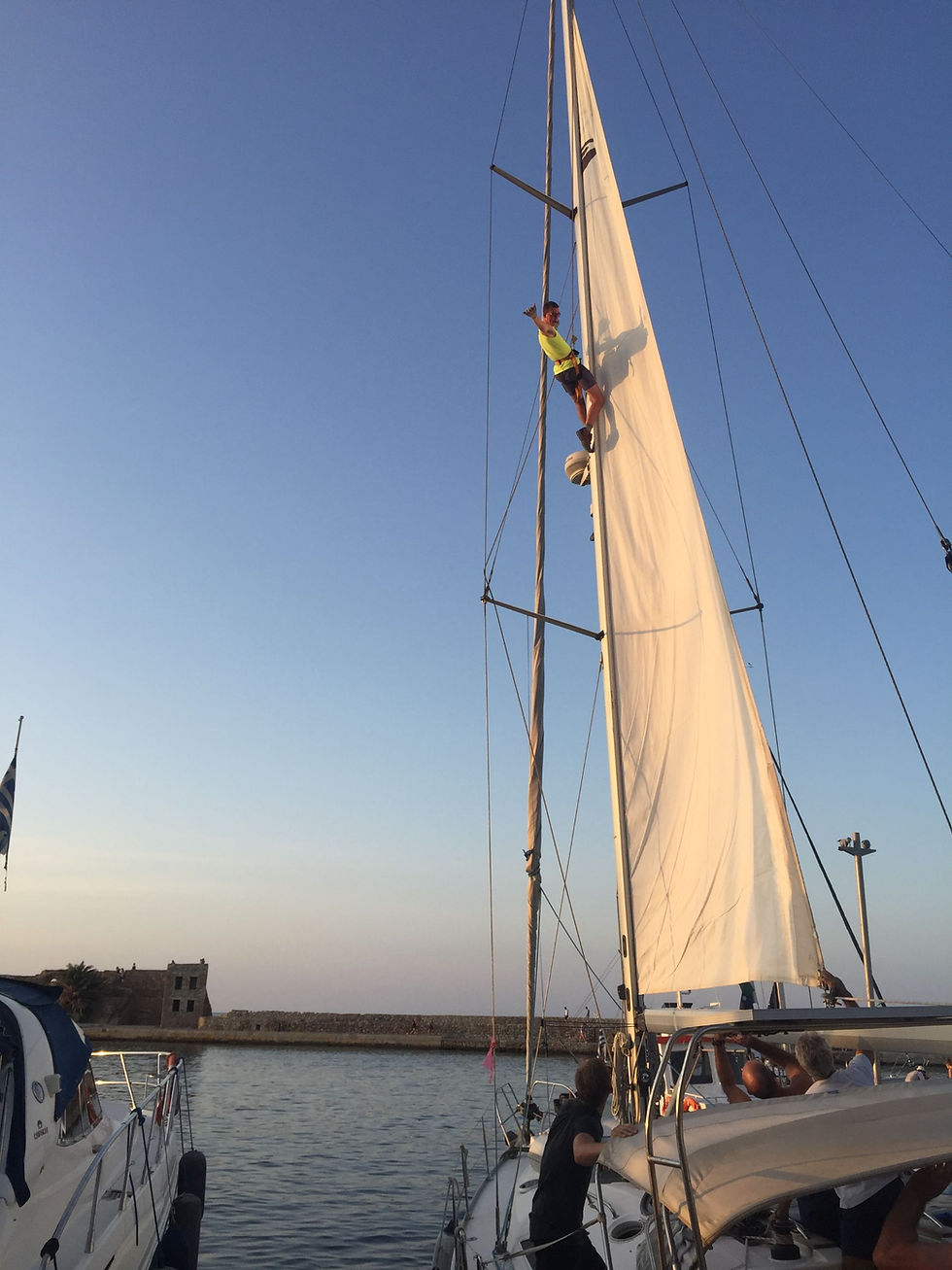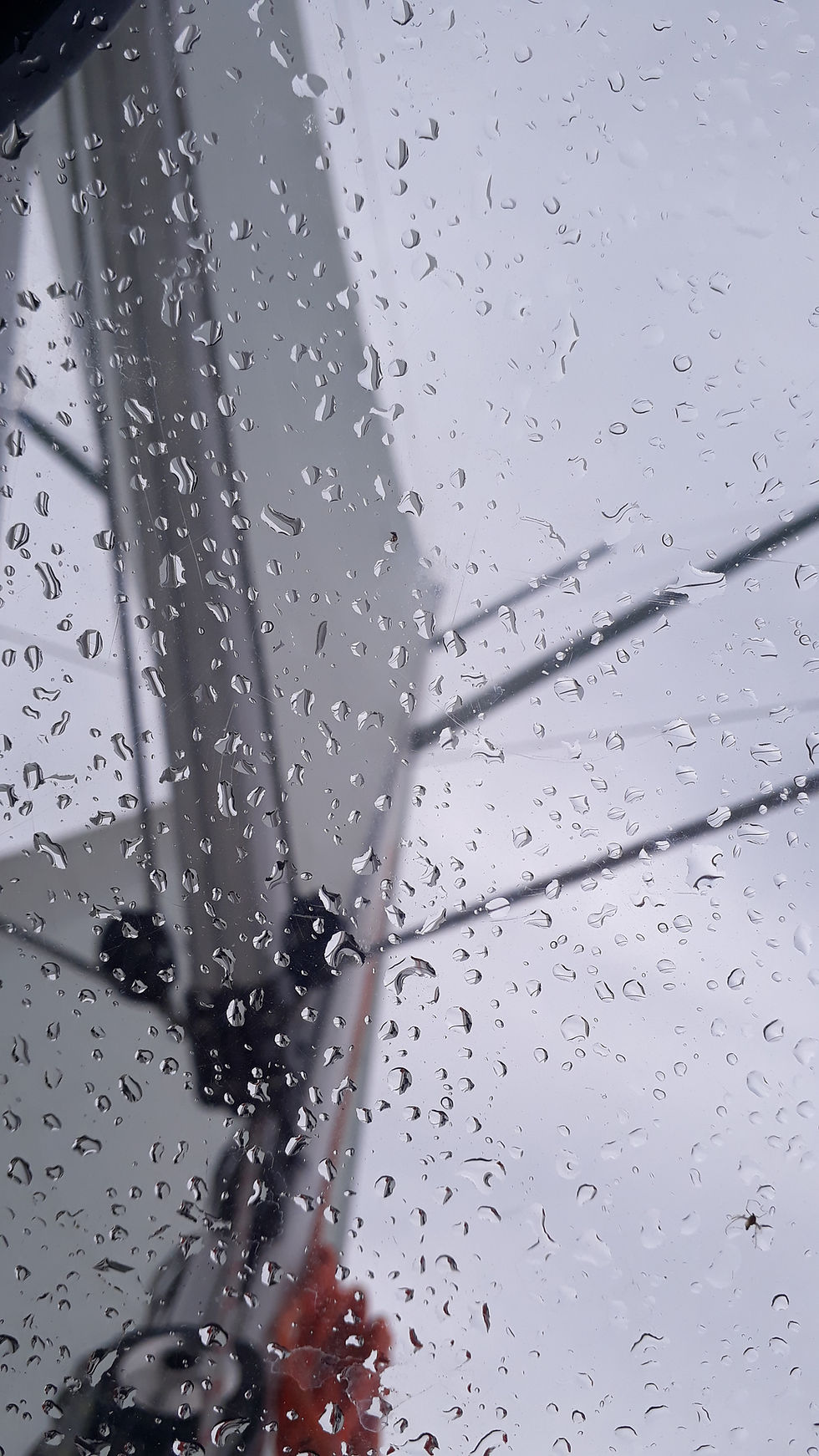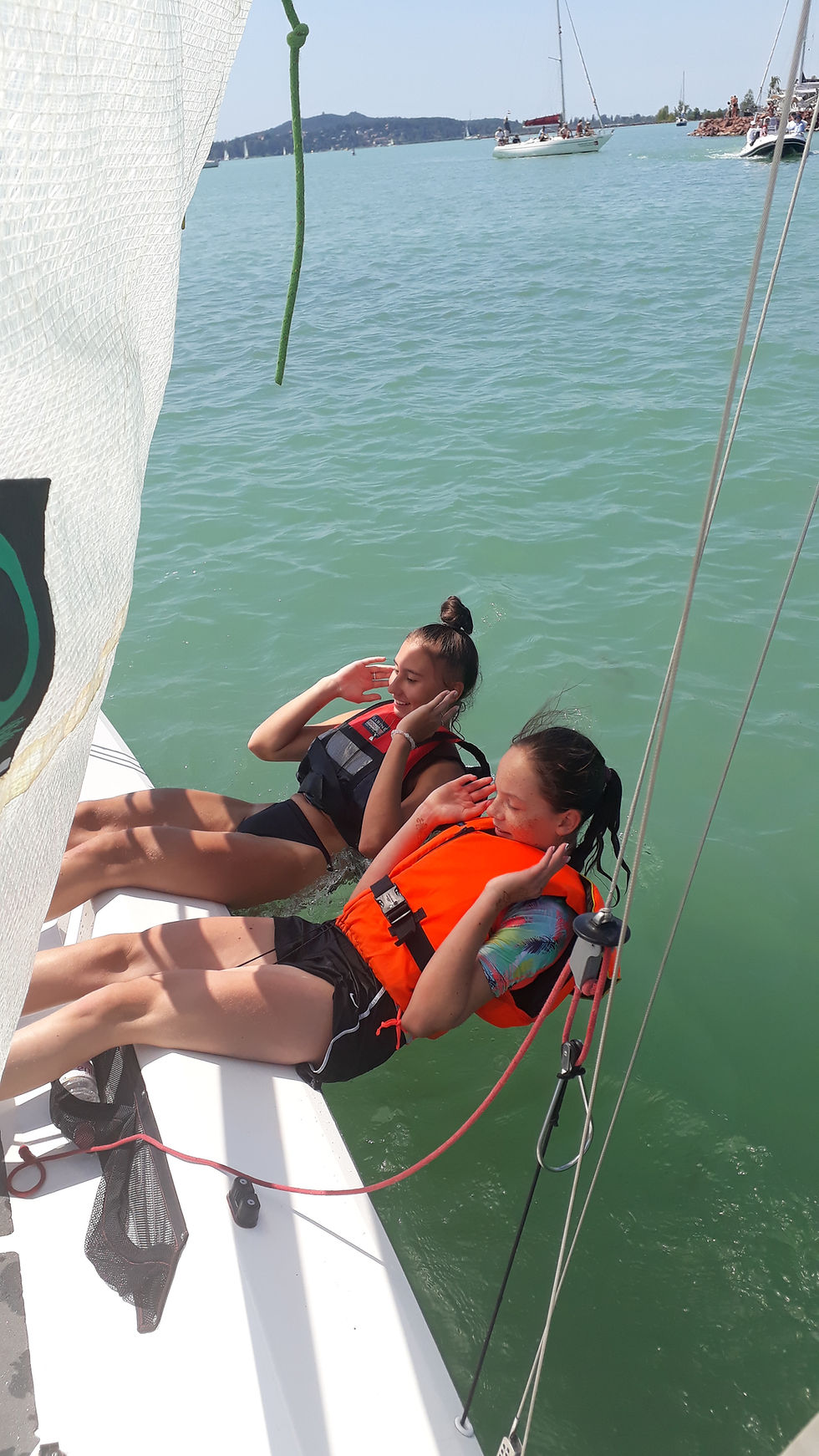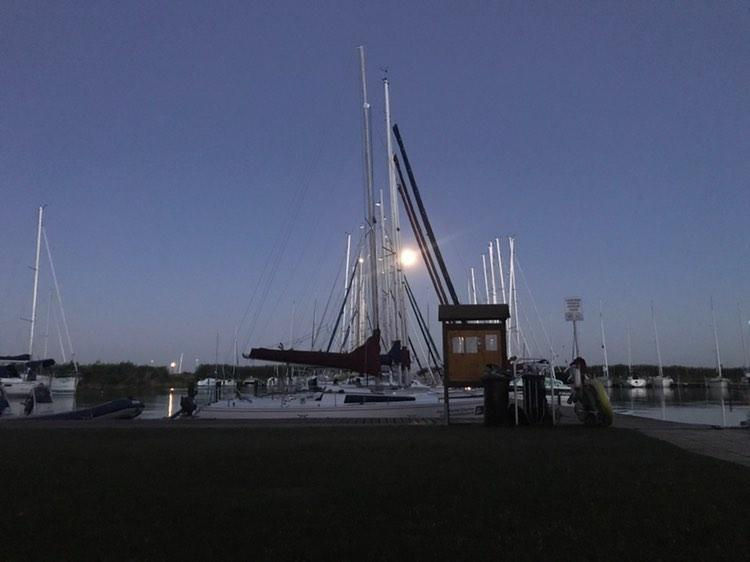A Day in the Life of a Sailing Instructor
- Jay (Year 12)
- Feb 22, 2021
- 12 min read
All times are in UTC+1. (Budapest time).
One knot is about 2 km/h.

0615 – Beep! Beep! Beep! My alarm goes off. I open my eyes and my brain instantly realises three things. One: It is already 26°C outside. Two: It is already bright outside. Three: Today is the first day of this week’s sailing camp and I’m going to be partially responsible for 20 children aged between 8 and 16 on the water of Lake Balaton between 0900 and 1700 as I try and keep them safe and teach them how to sail a 3-4 person sailing dinghy (a small boat for recreation and racing).
0620 – I come to my senses and start to panic as I become aware of the fact that I haven’t checked the latest wind and weather forecast for today, I grab my phone and open up Windfinder, my preferred wind and weather forecasting website. I navigate to superforecast. I start scrolling down the page, my phone screen is flooded by purple, which signifies low wind speed (1 to 3 knots [2-6 km/h]) from the west. The website shows all purple until 1300 where the colour changes to blue, which signifies better wind, it displays 8 knots [15 km/h] from the north. I become sceptical whether a shift in wind direction from the west to the north will only bring an increase of 6 knots of wind, as such changes at the Balaton usually bring bigger winds with them. I shrug it off as this wind will only come after lunch when I can discuss the course of action with the other instructors.

0630 – By now I have gotten dressed in casual clothes, packed up all my belongings and ready to leave my accommodation. I have to do this every day (I’ve gotten quite good at it), because my room, isn’t really a room. Her name is Annabelle, a Scholtz 8.8 sailing boat owned by Füred Yacht Charter. Annabelle is used during the days as an instructing vessel for adults, hence I can't leave my stuff there. Füred Yacht Charter is a bareboat charter company based at Balatonfüred which offers yachts for rent, has a team of instructors who give courses for adults to get their sailing licenses and hosts a sailing summer camp. I am employed as an assistant sailing instructor at the summer camp, but I also do odd jobs here and there.
0631 – I walk to the sailing clubhouse where I drop off my luggage in the ‘classroom’ on the second floor, really, it's just a big room with a couple of lines of tables and chairs in it. I then head down the stairs and into the storage hanger to get some equipment.
0632 – Standing at the bow (front) of Annabelle with a bucket and long brush in hand I prepare myself to scrub the deck of the 29 ft (8.8 m) sailboat. Now you may think this is an easy task, done in a jiffy, but no. The last person to rent this boat had left the deck in a less than appropriate fashion, with mud all over the stern (back), from pulling up a muddy anchor. Not only do I have to deal with Annabelle, but also Mirabelle, the Scholtz 8.8 next to Annabelle (don’t ask me why they named both the two identically looking boats ending with a ‘belle’). And the 41-foot (12.5 m) behemoth called Josephine. This task has been set by Ákos via text message, one of my superiors, yesterday at 1900.
If you want to know my method of washing the decks of boats, here it goes (it is quite fascinating): I spray the boat with Balaton water, a water pump sucks it up from the lake, (I use the thickest diameter hose because it is way easier to make a high-pressure spray – but of course, I have to gather it from the other end of the pier). Once there is water everywhere, I check to make sure all the windows are closed, and I haven’t soaked the whole of the inside. (Oops, I should probably do this before I turn on the water tap!) I then pour some elixir, I mean boat shampoo and water into a bucket and carry it to the centre of the boat. Using the brush, I scrub off all the mud and any other muck from the deck, then rinse off the shampoo or remaining dirt. Then I move onto the next two boats.

0720 – I walk to back to the clubhouse where I drop the bucket and brush and use its facilities to freshen up, grab my white long-sleeve company top and a bit of cash.
0735 – Hopping onto my ‘company bicycle’ (my boss’s bike that he hasn’t used in 5 years) I head off to the closest Bubbles, which is 20 minutes away – up a steep hill. (Bubbles is a non-stop self-service laundry network in Hungary where for a relatively cheap price I can wash my clothes.)
0755 – I put my top (singular – One. Single. Top.) into the washer and set it for the shortest time (40 minutes) and pay at the machine. I then head off to the Aldi across the street, to pick up something to eat, usually three kiflis (Hungarian bread rolls), three bananas and a pack of salami or ham, cheese, and a carton of kefir.
0803 – While sitting on the curb outside Bubbles I chew on my makeshift sandwich and look at the weather on Windfinder, yes again, seeing no change.
0835 – My top is now washed so I hop back on my bike to ride down the hill – going at about 20 km/h down this hill with dodgy brakes, unreliable tires and wearing thongs (Aussie word for flip-flops) is a great way to wake up in the morning – Though I don’t recommend it.

0845 – I greet the other instructors at the beach bar/coffee shop and talk about wind, sailing and how hot the weather will be today. Food is another topic that often comes up. At this point, I better introduce my fellow summer camp instructors. Peti is the main instructor, he’s been sailing since he was a little boy and has travelled around the world teaching sailing, skiing and other outdoor nature-related sports, and during the off-season, he is a PE teacher in Budapest. Part of the team there is also Marci, he’s a year older than me and has been sailing since he was about 10, he spends most of his summer at the Balaton and is currently attending university. Gyürke is our dedicated motorboat captain, while on the water and the kids are in the dinghies, we, the instructors and Gyürke are in the motorboat setting out the buoys, supervising and instructing the little sailors. Occasionally in cases of bad weather or scared younger ones, Marci or I jump into a dinghy to help calm the situation. With the motorboat, we can rescue children in case of an accident.
0900 – By now most of the children have arrived, except for the usual two or three kids who are always late. We let the parents know where the office is, in case they have some paperwork to catch up with and we usher the kids to the classroom. Here we introduce ourselves, set the parents off on their day and ask the children to introduce themselves.
0910 – We finish with the introductions and all the late arrivals have found their way to the classroom. The children get dressed in their swimming costumes and so do I and we go for a swim test, to make sure all the kids can swim without a lifejacket. I swim out a little way from the jetty and start treading water and we get all the kids to swim to me and back to the shore. We then get out and walk over to the dinghies. In the great heat of the summer, we dry up in no time.

0925 – There are three classes of dinghies we have at Füred Yacht, we have two Laser Picos, these are single or double-handed dinghies for very small children. We have four Laser Bahias, they can accommodate up to 5 little and 4 bigger children, most of the kids are in these boats. And we also have a Flaar 18, which is a racing dinghy that can hold about 5 kids, but we only let children sail this boat when we see they are competent enough to handle it properly.
We introduce the boats to the children and show them how to rig (set up) the boat, from hoisting the sails to setting up the rudder and daggerboard. We then also show them the correct procedure to turning in a boat as the helmsman (person steering) has to change sides depending on which side the wind is coming from. We let them all take a turn, then we set up the boats for a row. We don’t hoist the sails in this case, we only use the rudder and a few paddles, so the children get used to steering when on the water.
1200 – By this time, all the children are exhausted, and the lunch is due to arrive. As always, the lunch is late, too small, and usually tastes pretty bad. When the kids don’t touch their food, I gladly demolish it for them - I’m not picky at all.
1400 – We have a two-hour break after lunch, this gives time for swimming, digesting food and spending some time in the shade away from the sun. I had a chat about the weather with the instructors and decided it was fine to go. Though we would take a reef (reducing the sail area) to be on the safe side.

1420 – All boats reefed, and, on the water, we head out of the port and a decent 6-8 knot westerly gentle breeze powers the dinghies along the lake. We decided, that instead of circling the buoys we’d go on a longer trip towards ‘shipyard bay’ or Hajógyári Öböl.
1500 – The 6-8 knot breeze has now risen to gusts of 15 knots and some of the boats were really getting heeled over (leaned over), one of the boats which had the smallest children where very close to capsizing multiple times, so we kept close by with the motorboat.

1524 – I will probably never forget this moment. A huge gust of probably about 20 knots came in through the valleys and caught 3 of the 4 boats by complete surprise, they all capsized pretty much simultaneously. As we were nearest to the boat with the smallest and youngest, without hesitation I told Gyürke to start reversing, as soon as the gears in the 4-stroke clanked into reverse, I jumped in the water from the bow. The motorboat slipped away to aid the other capsized boats, in the meantime I started swimming at full power towards the young children. First, I checked they were all above water and accounted for, they, of course, all still had their buoyancy aids on. My next step was getting the boat back into its normal upright position. Now you may think this is an easy task, but with gusting winds and now all the crew wet including me, it was less than pleasant. I first tried to right the boat by myself, but I guess I didn’t have a big enough breakfast, because it didn’t budge, I had to get the children to help me right the boat which was very difficult as one of them was extremely frightened and was probably a bit in shock. After getting one of the older ones next to me on the daggerboard, we were finally able to right the boat. I jumped in and stabilised everything (as I was the heaviest) and then gave a hand to the other children to climb in. This procedure is very difficult as I had to keep the boat in the wind to make sure I don’t leave them behind, but boats are only steerable if there is water running through the rudder, and when you are stationary it is almost impossible to manoeuvre any boat. With great difficulty, I managed to get all the children on board, and I took the helmsman position (I started steering).

1530 – All boats righted I made my way towards the motorboat to unload the two little girls who were the most frightened and cold, so Peti could get them warmed up and calm them down. In the middle of all the chaos, Marci had also had to get into another boat. As he is a bigger lad than me, and with the now deficit of crew on my boat a few people got changed around to balance the weight on all boats. This quite a tricky manoeuvre, transferring sailors from one boat to the motorboat to another boat, with gusting winds and turbulent waters.
1540 – By now everyone is in their new place and all the boats are balanced, with the two very frightened girls still in the motorboat, most boats headed back towards the course that was laid out back near the port entrance, but it just happened that the new crew that was assigned to me were the couple oldest girls in the camp, and I had a bit more in common with them and was able to have nice conversations with them. I decided we could try and test the abilities of the Laser Bahia by sailing to one of the ports on the peninsula of Tihany. I called Peti and he said its fine as long as we got back in time. I was ecstatic that he let me, and I let him know that we would definitely be back in time. Famous. Last. Words.

1600 – Though by now the wind has eased up a bit (to about 10 knots) to our favour, the wind has shifted so we had the wind on our stern quarter and our sail setting was of a broad reach, which in layman’s terms is about 140° from the bow. This is the fastest point of sail on the Laser Bahia. And this Bahia had some special with which we were about to get a lot faster. There is a sail called the gennaker which is a hybrid of a genoa and spinnaker, simply it is an asymmetric downwind sail. The girls on my boat until now had a leisurely time chatting away, sipping away at their water, and occasionally listening and dancing to some of my tunes what was to come no one could prepare them for.
1601 – I said, “That’s it, I want to go fast.” Dalma and Réka look at me as if I had gone mad “Aren’t we going fast enough?” they said almost in unison. I replied, “I want to go faster.”. At the bow of the boat, I found all the running rigging for the gennaker and set it up all ready to be used. I clambered back to the cockpit and heaved, a few seconds later we had a wonderful red gennaker full of wind. I quickly handed the sheets (handling ropes) to Dalma and showed her how to use them. Having the gennaker up almost doubled our boat speed and now we were really flying.

1630 – Arriving at Tihany harbour we saw the beginning of a dying wind. We take down the sails and paddle the last few metres to the pier. Just as we tie off the harbour master walks up to us and demands that we pay for docking there. As I knew we’d only be there for a quick ice cream I negotiate with him and we agree that we will move the dinghy to where he knows there won’t be other visitors and we could stay for 10 minutes for free. I thanked him and started moving the boat. We got our ice creams quickly swallowed them.
1640 – I look out to the water and see a mirror; my worst nightmare had come true. We quickly run back to the boat and cast off and start paddling out of the harbour. Even when out of the breakwater there was not a fart of wind. From the raging gusts of the early afternoon, we were left with nothing. We were left out there doomed.
1650 – Ring. Ring. Ring. I look at my phone and see Peti’s name displayed. I explained our circumstance and our position and beg for him to pick us up with the motorboat. Without really much choice, he agreed.
1658 – The motorboat comes alongside us and Peti throws me a line, I tie it to the mast and the motorboat goes ahead and starts towing us.

1707 – Arriving back in Balatonfüred I help take the boat out of the water and pack away the sails. After saying goodbye to all the children Peti and I walk to the beach bar, here I am informed that I am paying for the drinks today as payment for the motorboat “rescue”.
1800 – After downing a few cokes and chilling at the bar Ákos gives me the wonderful task of cleaning another two boats before the renters arrive at 1900.
1900 – Finished with the scrubbing and cleaning I show the arriving guests to their boats and answer some of their questions about the instruments and features of the vessel. Walking back to the sail club house I pick up my belongings and drag them back to Annabelle and make my bed.

1930 – I walk over to the burger place nearby where I order two cheeseburgers. As I munch away at the second cheeseburger, I overhear a few people talk about the Blue Ribbon (Kék Szalag) sailing race and I realise that today is the day that it started. The Blue Ribbon is an around the Balaton sailing race and things can get very competitive. The finishers should be arriving later in the day. I quickly swallow the last bite of the burger and head back to the marina where I am based.
1945 – Walking past the pizza restaurant in Balatonfüred my persistent hunger persuades me to get a pizza (yes even after the first two cheeseburgers, and they weren’t small burgers) and take it with me to watch the race on the TV at the beach bar. I’ll save you the suspense, the RSM2 sailing catamaran team came first and completed the 84 nautical mile (155 km) race in 17 hours 52 minutes and 57 seconds.
It is safe to say that my hunger subsided after finishing off the pizza and my satisfaction was extremely high after a hard day of work, fun and some dramas.












































Comments